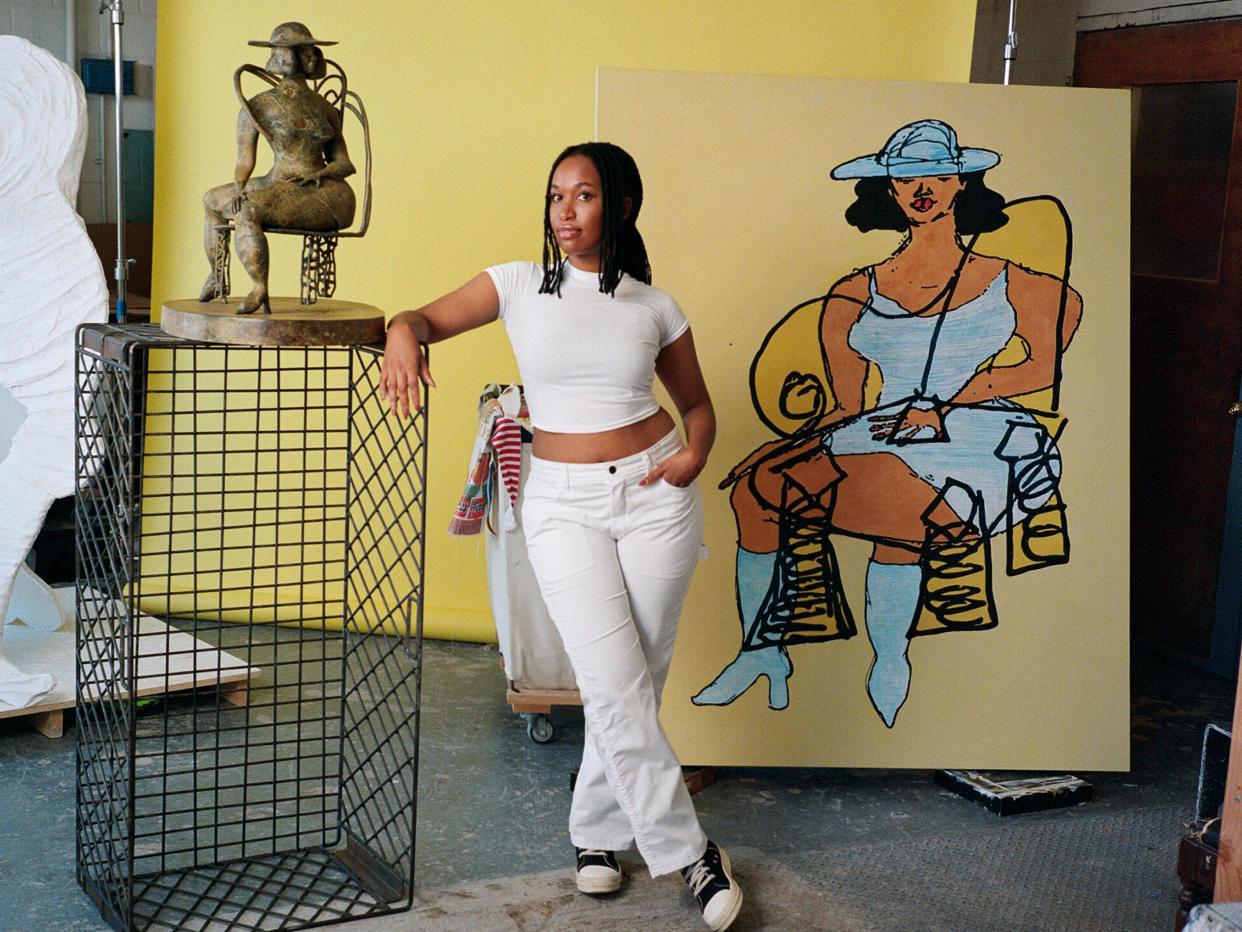‘Hip-hop honeys’ and sitting as a political act: why Tschabalala Self is one of America’s hottest artists

‘Imagine you’re on a bike, as opposed to a car, a train, or a plane,” says Tschabalala Self. “Imagine how the world appears, how quickly and easily you’re able to move through it. How clearly you can see people and they can see you.” She pauses. “Your worldview shifts depending on the vehicle you’re in. For me, it’s the same with bodies. Inside, we’re all essentially the same – but we’re moving around in different bodies that dictate our experience.”
This freewheeling analogy is characteristic of Self, who lives and works in New York’s Tri-State area. We’re chatting ahead of two projects she’s launching in London this month: the first, a large bronze sculpture of a seated figure in Coal Drops Yard, commissioned by Avant Arte, the organisation-cum-marketplace that aims to make art more accessible; the second, a solo show of new drawings, paintings, sculptures and functional objects at Pilar Corrias Gallery. With both, Self continues her exploration of the Black female body: “It’s the body I feel I can have the most honest conversation about because it’s my own.”
We imagine we’re free to behave as we wish – but there are still expectations and limitations that exist in public
The youngest of five, Self was born in 1990. Her parents grew up in New Orleans, moving to New York in the 1970s when her father was accepted on to the MFA writing programme at Columbia University. Her mother spent her spare time sewing pillows, cushions, curtains – “anything she refused to buy”. Self was raised in Harlem, a diverse neighbourhood soaked in art history, and her parents invested in their children a strong Black identity. “They experienced segregation in the American south,” she says. “But they were also the first generation there to experience integration. They had a lot of dual experiences that gave them a sophisticated understanding of racial dynamics in America – and I inherited those.”
Self was in her early teens when she started to notice how Black women’s bodies were treated in popular culture. “This was the early 2000s, the era of music videos and video vixens,” she says, referring to women of colour who performed as backing dancers for male artists. Self took inspiration from the racialised, objectified and hyperbolic representation of these so-called hip-hop honeys.
“In the beginning it was a lot of mirroring,” she says. “Then I started to interject more of my own intentions and aspirations onto the subject.” She started out printmaking, before developing the instantly recognisable art she is now known for: radiant assemblages of mostly female bodies that comprise printed, painted and sewn materials.
The new work at Pilar Corrias features intimate vignettes of men and women sitting on chairs, at tables and in front of mirrors. Titled Home Body, it explores how the personal and the performative co-exist within a domestic setting where, Self believes, identity and gender politics can still run riot. “When we think of the home,” she says, “we think of interiority and privacy – and those imply a sense of freedom. We imagine we’re free to behave as we wish. But there are still expectations and limitations that mirror, if not magnify, those that exist in public.”
Seated, the sculpture at Coal Drops Yard, takes one of those unnamed women and puts her on public display, throwing up questions about such seemingly straightforward things as a Black woman taking up space or the act of sitting itself. “To be seated is relatively simple,” she says, “but it can also be political.” An act of resistance reminiscent of sit-ins and a symbol of permission and basic human rights. Accompanying the sculpture is a video that shows Londoners talking about sitting from their favourite places to do so.
Self is now one of the most sought-after artists in the US, although she balks at the idea of the next bright young thing. “Once you concede to it,” she says, “you’re essentially conceding to your own commodification and objectification. And how does that benefit you in the long run? Because when people start to perceive objects as old, or no longer useful, they usually throw them out.”
Self does, however, want her art to reach as many people as possible, and for viewers to stand in front of her work and experience “a transcendent moment”. “It doesn’t have to be a realisation about the work,” she says. “It could be a personal realisation. I want to make people feel like they have more perspective, and the tools to navigate the world a little more easily.” No matter what body – or vehicle – they’re moving around in.
Seated is at Coal Drops Yard until 31 January; Home Body is at Pilar Corrias until 17 December; both London.

 Yahoo Movies
Yahoo Movies 
